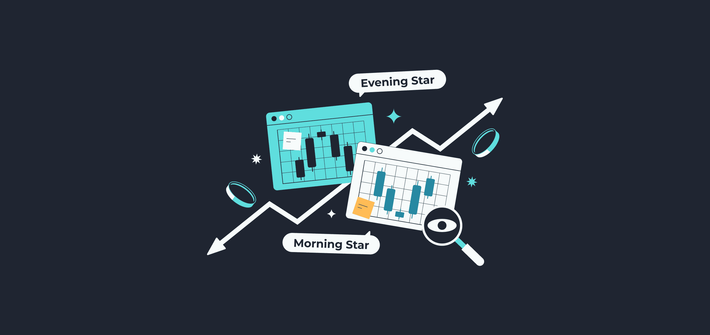What are Morning Star and Evening Star Patterns?
If a price chart is a story, most candlesticks are the sentences. Every now and then, a few candles appear that flip the script entirely. Signals that hint a trend reversal may be near. The Morning Star and Evening Star candlestick patterns are two of those turning points.
For crypto traders, especially beginners, these setups are a way out of the “react and regret” cycle, buying after a pump, selling after a dump, and always chasing what’s already happened. Instead of reacting, Morning and Evening Stars help you anticipate when momentum might shift.
Key takeaways
- The Morning Star is a three-candle bullish reversal pattern: a long bearish candle, a small indecision candle (the “star”), and then a strong bullish candle that closes deep into the first one’s body. It forms at the bottom of a downtrend.
- The evening star pattern is a strong bullish candle, a small indecision candle, then a bearish one that closes deep into the first candle’s body, usually found at the top of an uptrend.
- Morning and Evening Stars are among the most respected reversal setups in both stock and crypto markets, but they’re not bulletproof.
The Morning Star: a bullish reversal pattern
The Morning Star is a classic bullish reversal signal that shows up after a downtrend. It’s made of three candles and basically says, “The selling spree might be over. The buyers are waking up.”
Anatomy of the morning star
- Candle 1, The Bear A big, red, bearish candle that confirms sellers are still in full control. The trend is down, and momentum is on their side.
- Candle 2, The “Star” A small-bodied candle that can be red, green, or even a Doji. This candle is where the tug-of-war begins. Sellers try to keep pushing lower but fail to make much progress. Buyers start showing up, and the market hesitates. That’s the indecision point.
- Candle 3, The Bull A strong green candle that charges upward and closes well into the body of Candle 1. This is the confirmation that the tide has turned. Buyers have stepped in with conviction.
The psychology behind a morning star pattern
Each candle tells a mini-story:
- Candle 1: Bears are confident. Selling pressure is strong, and nobody’s questioning it yet.
- Candle 2: Sellers start losing momentum. Buyers quietly appear, and the session ends in a draw.
- Candle 3: Buyers sense weakness, move in aggressively, and flip control. The market mood shifts from fear to cautious optimism.
If you imagine this like a boxing match, the first round is a knockout punch from the bears, the second is both sides catching their breath, and the third is the bulls landing a decisive counter.
The Evening Star: A bearish reversal pattern
The Evening Star is basically the Morning Star’s darker twin. A bearish reversal pattern that appears after an uptrend. When you see it, it usually means buyers are getting tired and sellers are ready to take over.
Anatomy of the evening star
- Candle 1, the Bull A strong green candle that screams buyer dominance. The uptrend looks healthy, and optimism is high.
- Candle 2, the “Star” A small-bodied candle that signals hesitation. Buyers can’t keep the rally going, and sellers begin to test the waters.
- Candle 3, the Bear A large red candle that closes deep into Candle 1’s body, the official “handover” moment where selling momentum confirms the reversal.
The psychology behind an evening star pattern
- Candle 1: Bulls are in control, and everyone’s chasing green candles.
- Candle 2: Price stalls. Momentum fades. The smart money starts locking in profits.
- Candle 3: Sellers take their shot, and buyers start bailing out, confirming the shift from greed to fear.
It’s the same three-act structure as the Morning Star, just flipped upside down. The market goes from euphoria to hesitation to reality check.
The 3 C’s: components, context, and confluence
Spotting a Morning or Evening Star is one thing; trusting it enough to trade it is another. To separate strong signals from random noise, remember the 3 C’s:
1. Components (What it’s made of)
- Candle 2 must be small. The smaller it is, the better, especially if it’s a Doji, where the open and close prices are nearly identical. That shows pure indecision.
- Candle 3 must be decisive. It needs to close well into Candle 1’s body. A weak or short Candle 3 doesn’t confirm anything.
- If Candle 2 has a big body, the pattern loses its meaning. It’s not a pause; it’s just another move in the trend.
2. Context (Where it happens)
A perfect-looking pattern in the wrong place means nothing.
- A Morning Star is only meaningful at the end of a downtrend, ideally after several bearish candles.
- An Evening Star matters only at the top of a rally.
Think of it like spotting rain clouds: the same cloud means different things depending on whether you’re in the middle of a storm or under a clear sky.
For example:
- A Morning Star forming after a four-week decline could signal a true shift.
- But if it appears in a choppy, sideways market, it’s probably just noise.
3. Confluence (What backs it up)
No pattern should stand alone. Always look for supporting evidence, technical or psychological, to confirm the setup.
Check for:
- Support or resistance levels. Is the Morning Star forming near a key support zone? Or is the Evening Star sitting under a resistance ceiling?
- Volume behavior. In a Morning Star, volume typically spikes on Candle 1, dips on Candle 2, then surges again on Candle 3, showing real buying pressure returning. The Evening Star mirrors that pattern in reverse.
- Indicators. RSI divergence, for example, adds confidence, like a bearish RSI divergence backing up an Evening Star.
Confluence doesn’t just boost your win rate. It helps filter out false alarms.
Trading strategies
So, once you’ve spotted a valid Morning or Evening Star and confirmed it with confluence, how do you trade it?
Let’s break it down.
Trading the morning star
Entry options
- Aggressive approach: Enter as soon as Candle 3 closes. You’re betting that momentum will carry through immediately.
- Conservative approach: Wait for a small pullback or “retest”, often a dip toward Candle 3’s midpoint, and enter on that minor correction.
Stop-Loss Placement: Put your stop just below the lowest point of the Star candle (Candle 2). If the price breaks below that, the setup is likely invalidated.
Target Idea: Many traders aim for the next resistance zone or use a 1:2 or 1:3 risk-reward ratio. The exact target depends on your timeframe and risk tolerance.
Trading the evening star
Entry options
- Aggressive: Enter at the close of Candle 3 as selling confirms.
- Conservative: Wait for a brief bounce (a “retest”) toward Candle 3’s midpoint before shorting.
Stop-loss placement Set it just above the height of the Star candle. If price breaks above, the bearish setup likely failed.
Profit target Look for the next support area, or use your preferred risk-to-reward ratio to define an exit.
How reliable are these patterns?
Morning and Evening Stars are among the most respected reversal setups in both stock and crypto markets, but they’re not bulletproof.
Crypto, especially, is known for fakeouts and volatility. That’s why confirmation and confluence are everything. Combining these patterns with volume spikes, RSI signals, and key levels makes them much more reliable.
Without confirmation, they’re just interesting shapes on a chart.
FAQs
1. What does a Morning Star look like?
It’s a three-candle pattern: a long bearish candle, a small indecision candle (the “star”), and then a strong bullish candle that closes deep into the first one’s body. It forms at the bottom of a downtrend.
2. What does an Evening Star look like?
Same concept, reversed: a strong bullish candle, a small indecision candle, then a bearish one that closes deep into the first candle’s body, usually found at the top of an uptrend.
3. Do they need gaps to form?
In traditional stock charts, price gaps make the pattern cleaner. But in crypto, where markets trade 24/7, gaps are rare. The pattern still counts without one.
4. How reliable are Morning and Evening Stars in crypto markets?
They work best with confirmation. Because crypto can be whippy, it’s wise to wait for volume or indicator support before trading purely off the pattern.
5. Can morning and evening star patterns fail?
Yes. Sometimes a Morning Star forms and the price still dumps, or an Evening Star appears and the uptrend continues. It happens. That’s why you always pair these with other tools and good risk management.
Final Thoughts
At their core, the Morning and Evening Star patterns aren’t “magic signals.” They’re visual snapshots of changing sentiment. A tug-of-war between buyers and sellers is reaching its turning point.
- The Morning Star marks the moment when exhaustion gives way to optimism.
- The Evening Star shows when confidence turns into caution.
Your goal as a trader is not to catch every flicker of change but to wait for clarity, for that Candle 3 moment where the winner is obvious.
When you start to see these setups not just as candles but as conversations between buyers and sellers, you’ll begin to trade differently. You’ll move from reacting to predicting, from following the crowd to anticipating it.
And that’s where the real edge begins.
Important note: These materials are for general informational purposes only and do not constitute financial, investment, or professional advice. Cryptocurrency investments involve significant risks, including potential substantial financial loss, and we do not endorse specific investments, tokens, or projects. Always conduct your own research and consult qualified financial or legal professionals before investing, as TabTrader disclaims liability for any losses arising from reliance on these materials to the fullest extent permitted by law.




